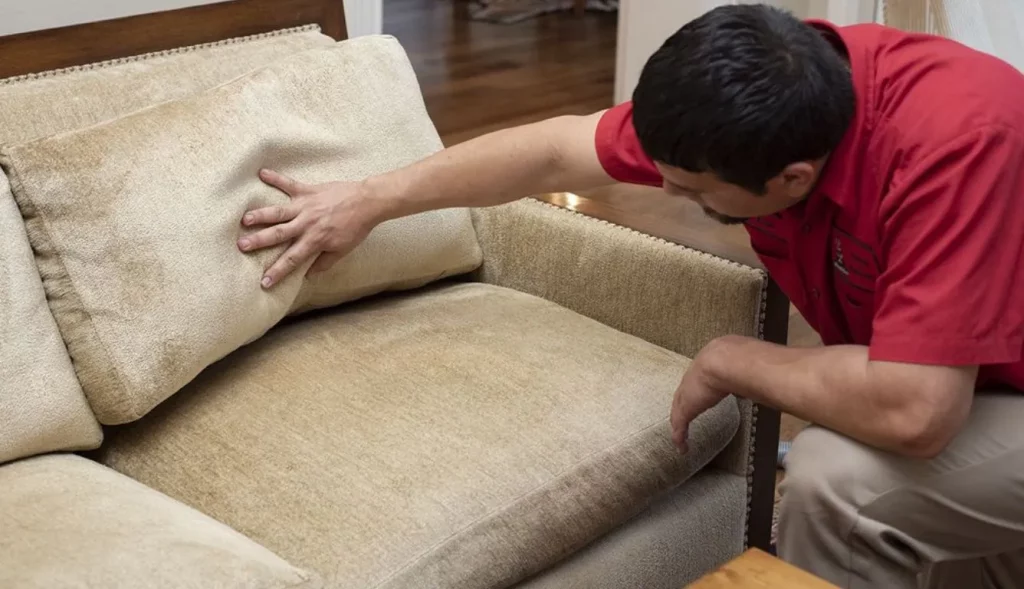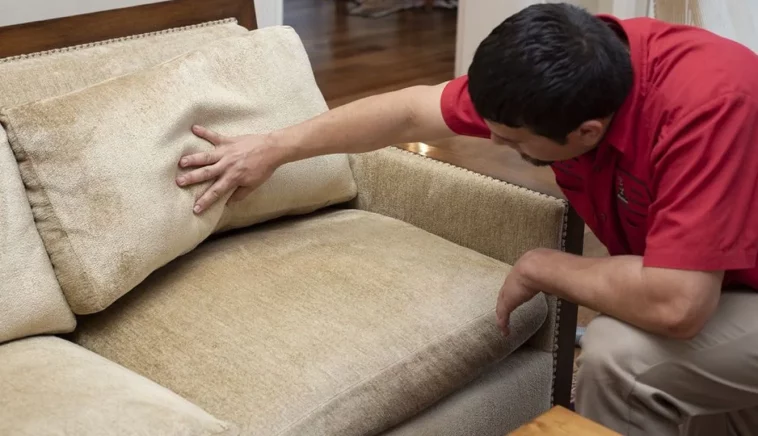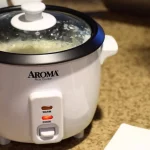Key Takeaways:
- Check the cleaning code tag first — “W,” “S,” “WS,” or “X” tells you which products are safe to use.
- Use a gentle detergent or upholstery cleaner diluted in water for water-safe fabrics.
- For solvent-only couches, dry cleaning solutions or rubbing alcohol work best.
- Always blot stains, never scrub — scrubbing can damage the fibers and spread the stain.
- Vacuum regularly, use a soft brush, and let the couch air dry completely to prevent odors and mildew.
To clean a polyester couch effectively, first check the fabric’s cleaning code tag. For “W” or “WS” fabrics, mix mild detergent with warm water and gently blot stains using a clean cloth. For “S” fabrics, use a solvent-based cleaner or rubbing alcohol. Always vacuum before cleaning, test products on a hidden spot, and let the couch air dry completely to restore its freshness.
Introduction
If your couch could talk, your polyester one would probably say, “Hey, I’ve seen things.” From spilled coffee and pizza nights to your dog’s secret nap sessions — that sofa has been through it all. The good news? Polyester is one of the most forgiving couch fabrics out there. The bad news? You still have to clean it once in a while (sorry, vacuuming the crumbs doesn’t count).
Cleaning a polyester couch doesn’t have to feel like a chore or a chemistry experiment. With a few simple tools, a little patience, and some insider know-how, you can make your couch look, feel, and even smell like new again — no expensive cleaning service required. Whether you’re tackling a mystery stain, a pet accident, or just general “life grime,” this guide will walk you through exactly how to do it safely and effectively.
So grab a clean cloth, roll up your sleeves, and let’s get that couch back to its former glory — the one that made you say, “Yep, this looks cozy enough to binge-watch my entire weekend.”

Importance of Cleaning a Polyester Couch
A polyester couch, while durable and resistant to stains, requires regular cleaning to ensure its longevity. Over time, dirt, dust, and stains can accumulate, diminishing the overall appearance and potentially causing damage. A clean couch not only enhances the ambiance of the living space but also promotes a healthier environment by removing allergens and preventing the growth of harmful microorganisms.
Benefits of Regular Maintenance
Regular maintenance of a polyester couch comes with numerous benefits. It not only extends the lifespan of the furniture but also preserves its original color and texture. Additionally, routine cleaning helps prevent the need for more intensive cleaning methods or professional services in the future, saving both time and money.
Preparing for Cleaning
Gathering Necessary Supplies
Before embarking on the cleaning process, it’s crucial to gather the necessary supplies. These may include a vacuum cleaner with appropriate attachments, mild detergent, white vinegar, baking soda, a soft brush, and clean microfiber cloths.
Checking Manufacturer’s Instructions
Every polyester couch is unique, and it’s essential to check the manufacturer’s instructions before cleaning. Some fabrics may have specific cleaning requirements or recommendations to maintain their integrity.
Vacuuming the Couch
Removing Loose Dirt and Debris
Initiate the cleaning process by vacuuming the couch thoroughly. This step helps remove loose dirt and debris from the surface and crevices, preventing them from being pushed further into the fabric during the cleaning process.
Using Appropriate Attachments for Different Areas
Utilize the appropriate vacuum attachments for different areas of the couch. For example, a brush attachment is effective for fabric surfaces, while a crevice tool can reach between cushions and seams.
Spot Cleaning Stains
Identifying Different Types of Stains
Stains on a polyester couch can vary, including food, beverage, or pet stains. Identifying the type of stain is crucial for selecting the most effective cleaning method.
Choosing the Right Cleaning Method
Different stains require different cleaning solutions. Homemade cleaning solutions using common household items like vinegar, baking soda, and dish soap can be effective for spot cleaning. Adjust the mixture based on the severity and type of stain.
Mesenchymal Stem Cells: A Brief Detour into Therapeutic Potential
As we delve into the intricacies of couch cleaning, let’s take a moment to explore the fascinating world of stem cells, particularly mesenchymal stem cells (MSCs). These pluripotent cells have shown immense therapeutic potential in various clinical applications.
MSCs, derived from sources such as bone marrow, adipose tissue, and umbilical cord blood, exhibit multilineage differentiation potential. In numerous preclinical and clinical studies, MSC-based therapies have demonstrated beneficial effects in tissue repair, immune modulation, and the treatment of autoimmune diseases.
Stem Cell Therapy: A Parallel Journey
Just as we focus on the therapeutic effects of cleaning a couch, let’s draw a parallel with the therapeutic applications of stem cell therapy. Stem cell treatments, whether using embryonic, adult, or mesenchymal stem cells, have shown promise in addressing a wide range of medical conditions.
Homemade Cleaning Solutions
DIY Solutions using Common Household Items
In a similar vein to the versatility of stem cells, homemade cleaning solutions offer a cost-effective and eco-friendly approach. Vinegar, known for its antibacterial properties, can be combined with baking soda and dish soap to create effective stain-removing mixtures.
Recipes for Effective Stain Removal
Experiment with different recipes based on the nature of the stain. For instance, a combination of vinegar and baking soda may tackle general stains, while a dish soap solution could be effective against greasy spots.
Exploring the Wide Range of Stem Cell Applications
Just as we address a wide range of stains on a polyester couch, stem cells also exhibit a wide range of therapeutic applications. From cardiac function to tissue repair, MSCs have proven effective in various clinical settings.
FAQs About Cleaning Polyester Couches and Stem Cell Therapy Integration
Regular cleaning preserves the couch’s appearance, prevents damage, and creates a healthier living environment.
Gather a vacuum cleaner, mild detergent, white vinegar, baking soda, a soft brush, and clean microfiber cloths.
Yes, DIY mixtures using vinegar, baking soda, and dish soap can be highly effective for stain removal.
The article draws parallels between the versatility of stem cells, especially mesenchymal stem cells, and effective couch cleaning methods.
Yes, checking manufacturer’s instructions is crucial to ensure the cleaning process aligns with the fabric’s specific requirements.
Stem cell therapies, including mesenchymal stem cells, have shown therapeutic potential in various clinical settings, addressing conditions like tissue repair and autoimmune diseases.
Yes, stem cells can be derived from sources such as bone marrow, adipose tissue, and umbilical cord blood, each with unique properties and applications.
The article correlates the versatility of stem cells with their therapeutic potential, addressing a diverse array of medical conditions.
While the general cleaning steps apply, it’s crucial to check the manufacturer’s instructions for specific requirements based on the couch’s fabric.
Conclusion
In conclusion, the regular maintenance of a polyester couch is vital for its longevity and aesthetic appeal. By following the outlined steps, from gathering supplies to employing homemade cleaning solutions, you can ensure a clean and inviting living space. And, as we took a brief detour into the world of mesenchymal stem cells and stem cell therapy, we find parallels in the versatility and therapeutic potential of both effective couch cleaning methods and the fascinating field of regenerative medicine. Whether dealing with stains or medical challenges, understanding the nuances leads to better outcomes and a healthier environment.






GIPHY App Key not set. Please check settings